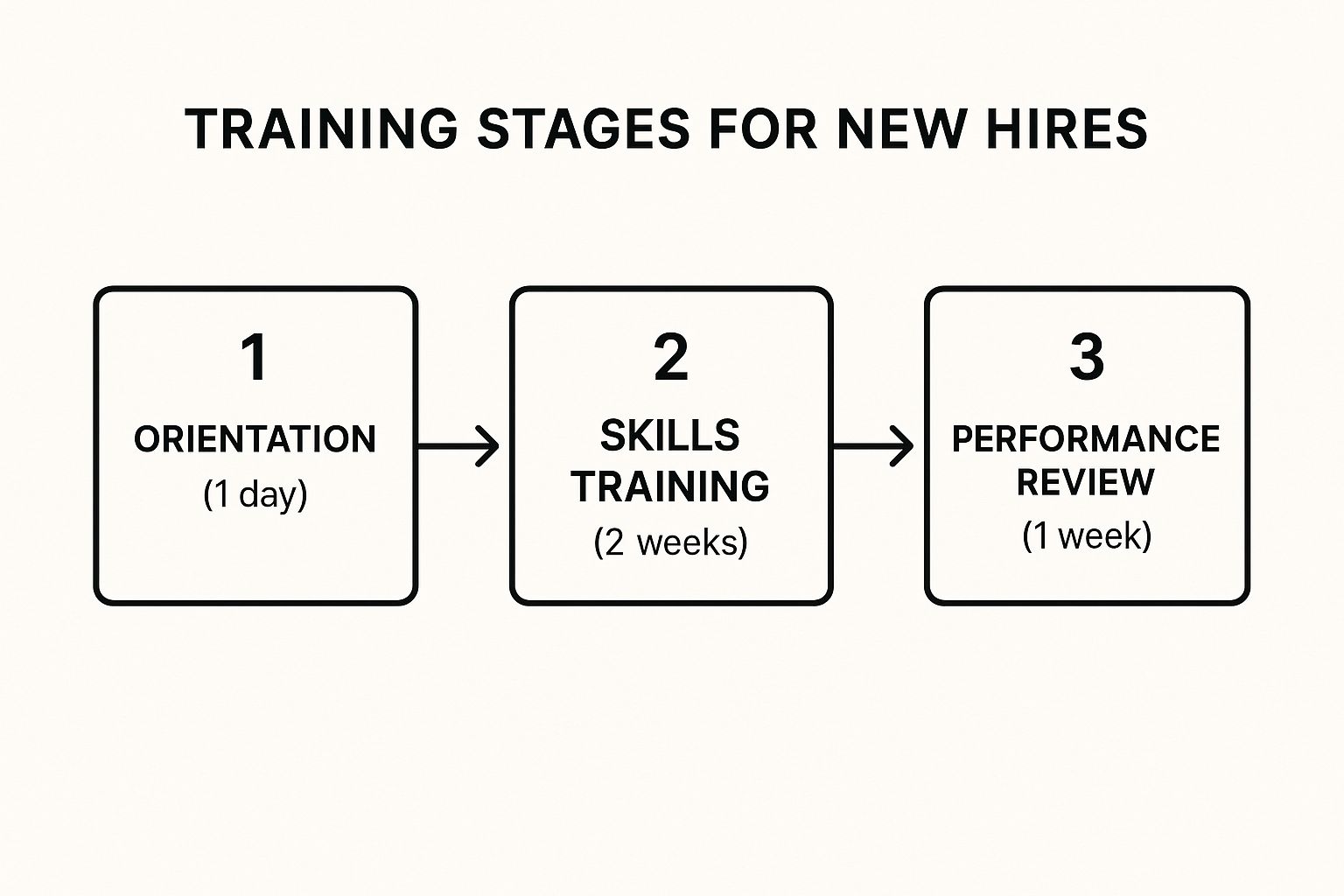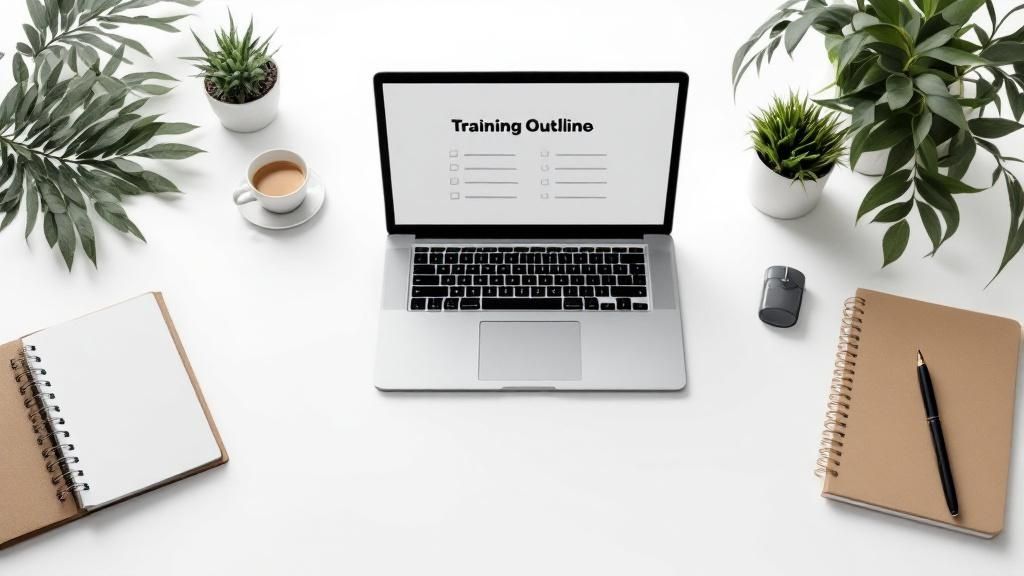The best training programs don't start on an employee’s first day—they start long before. Success comes from laying a strategic foundation that goes beyond a simple to-do list. It’s about creating a role-specific plan, getting their complete toolkit ready, and prepping your team for their arrival.
When you do this work upfront, a new person walks in the door feeling expected, valued, and ready to make a real contribution from day one.
Setting the Stage: Essential Prep Before Day One
The effort you put in before a new hire's start date has a massive impact on how quickly they find their footing and how successful they are in the long run. An unstructured start just creates anxiety and confusion. On the other hand, a thoughtful, well-prepared beginning builds confidence and loyalty right away. Your goal here is to get rid of the guesswork and empower them from the get-go.
This isn’t just about ticking off administrative boxes; it’s a crucial piece of your training strategy. And it pays off. Research shows that companies with formal, in-depth employee training programs see a 218% higher income per employee compared to businesses that don't have structured training. That’s a huge difference.
Craft a Role-Specific 30-60-90 Day Plan
A one-size-fits-all onboarding plan just doesn't cut it. For each role, you need to build a clear roadmap that shows what success looks like at key milestones. This plan acts as a guide for both the new employee and their manager, setting clear expectations from the very beginning.
Here’s how I think about it:
- The First 30 Days: This is all about learning. The main goal is for them to soak up everything they can about the company culture, who's who, key processes, and how the team works together.
- Days 31-60: Now, the focus shifts to contributing. They should start taking on more independent tasks and collaborating on smaller projects, putting what they've learned into practice.
- Days 61-90: This is about ownership. By this point, the employee should be managing their core responsibilities with more autonomy and even starting to spot opportunities for improvement.
A well-crafted 30-60-90 day plan is more than just a list of tasks. It’s a powerful communication tool that prevents overwhelm and aligns expectations, making sure your new hire knows exactly what they need to do to win.
Put Together Their Complete Toolkit
Can you imagine showing up for a new job and not having a computer password or knowing who to ask for a simple question? It’s incredibly frustrating. Preparing a complete toolkit in advance prevents that entire mess. To make sure your training is effective right from the start, it's a good idea to incorporate modern instructional design best practices.
A great first week sets the tone for everything that follows. Here’s a simple blueprint you can adapt to make sure those first few days are productive and positive.
Your First Week Onboarding Blueprint
This table helps you map out a journey, moving from initial orientation to skills development and final review. It’s a great way to visualize the process.

This visual really underscores that effective training isn't a one-off event. It’s a journey that requires dedicated time for each stage to truly stick.
Crafting an Unforgettable First Week

Let's be honest, a new employee's first week is about so much more than just ticking off HR boxes and setting up a computer. It's the foundation for their entire career with you. The real goal isn't just to get them logged in, but to make them feel like they've truly joined the team and found their place.
When you nail this first impression, you swap out those first-day nerves for genuine excitement. You’re not just filling a role; you’re showing a new team member that they belong here, and that’s how you build loyalty from day one.
Go Beyond Paperwork: Mix Admin with Authentic Connection
Day one sets the tone. Of course, you have to get the payroll and IT logistics handled, but that shouldn't be their entire reality for the first eight hours. The trick is to weave these necessary tasks into a day that’s genuinely welcoming.
One of the best things you can do is schedule a casual team lunch or a simple coffee run. It breaks the ice and lets the new hire meet everyone in a relaxed setting, seeing them as people first and colleagues second. It’s a small thing, but it does wonders to ease the anxiety of being the "new person."
I also swear by assigning an onboarding buddy. This should be a peer, not their manager. This buddy becomes the go-to person for all those little questions a new hire might feel awkward asking their boss—things like, "Where's the good coffee?" or "What's the real dress code?"
Your mission for that first week is crystal clear: make your new hire feel seen, supported, and connected to the bigger picture. When people understand why their job matters, they don't just work harder—they care more.
Engineer an Early Win
Nothing fuels confidence like a small, early victory. The worst thing you can do is throw a new hire into the deep end with a massive, complicated project they aren't prepared for. That just leads to overwhelm and self-doubt.
Instead, give them a small, well-defined task they can knock out in their first few days. It has to be something manageable with a clear finish line. For a new marketing hire, maybe it's analyzing one social media post and pulling out a key insight. For a new field tech, it could be as simple as organizing their section of the supply van. It works.
When they complete that first task, it provides a huge psychological boost. It proves to them (and to you) that they can contribute right away and gives them something concrete to discuss in their first check-in with their manager.
Here are a few other impactful things you can build into that first week:
- Job Shadowing: Have them shadow a seasoned team member for a couple of hours. Seeing the core work in action is invaluable.
- Department Intros: Set up quick, 15-minute meetings with heads of other departments they'll be working with.
- Our Story: Ask a veteran employee to sit down with them and share the company's origin story, its mission, and the real "why" behind what you do.
By Friday afternoon, your new hire should have more than just a laptop and a login. They should have a few new work friends, a solid grasp of their role, and the confidence that only comes from getting a win under their belt. That’s how you set someone up for long-term success.
Mastering On-the-Job Coaching and Mentorship

While formal training gets everyone on the same page, the real learning happens in the field. This is where hands-on coaching and genuine mentorship bridge the gap between knowing the theory and actually doing the work. The goal is to get your new hire thinking critically and solving problems like a seasoned pro.
This isn’t about just showing someone a process once and walking away. It's a focused coaching effort that turns observation into true capability. We’re moving beyond simply training people on tasks and starting to coach them on how to approach their work with confidence.
The Art of Structured Shadowing
Shadowing should be active, not passive. Having a new hire just follow a veteran around for a day is a recipe for glazed-over eyes and very little retained knowledge. It’s a huge missed opportunity. Instead, you need to structure the experience with clear goals.
Before you even start, get both the new hire and the mentor on the same page. The new person needs to know what specific things to look for, and the mentor should be ready to explain the "why" behind every action. Urge the trainee to take notes and ask plenty of questions—this transforms a passive viewing into an interactive lesson.
A game-changing technique is to have the mentor narrate their thought process. Hearing a simple, "Okay, I'm grabbing this tool because it won't damage the material," is a thousand times more valuable than just watching someone pick something up.
For your teams out in the field, this is where a tool like Nora can be incredibly useful. Instead of fumbling with a notepad, the new hire can send quick voice notes or photos of what they're seeing straight to a central log using WhatsApp. This creates an organized, searchable record of their observations and questions, which is invaluable for reviewing and solidifying what they’ve learned.
From Watching to Doing: The Gradual Release Model
The most reliable way I’ve seen to build real self-sufficiency is by gradually handing over the reins. It's the classic "I do, we do, you do" approach. This model is perfect for training new employees because it builds confidence step-by-step, moving them from dependent to independent.
Here’s how it looks in practice:
- I Do (You Watch): The manager or mentor performs the task from start to finish. The new hire just observes. This is all about demonstration and clear explanation, much like the structured shadowing we just talked about.
- We Do (You Help): The new hire jumps in and helps with parts of the job. Maybe they handle one specific step or manage a piece of equipment under close supervision. It's their first real hands-on experience in a safe, controlled way.
- You Do (I Watch): Now, the roles are reversed. The new hire takes the lead while the mentor watches, ready to offer support and feedback. This is the final test—proving they can handle the task safely and correctly on their own.
Giving Feedback That Builds, Not Breaks
Real-time feedback is crucial, but how you deliver it makes all the difference. It can either empower someone or completely shut them down.
Vague comments like "good job" or "that's wrong" are useless. Be specific and deliver the feedback right when it happens, not hours later. If you spot a mistake, address it constructively on the spot.
Frame your feedback around the action and its result, never the person's character. Instead of saying, "You're being careless," try something like, "When that valve is left partially open, it creates a leak risk. Let's make sure we get a tight seal every time." This corrects the behavior without making it personal, which keeps the new hire open to advice. This supportive loop is really the heart of great coaching.
Bringing Digital Tools into Your Training Program

Let's be realistic: your senior team members can't be everywhere at once. This is where technology becomes your biggest ally in training. When you bring digital tools into the mix, you're not trying to replace human connection. You're actually making it more powerful by freeing up your managers to focus on the hands-on coaching and mentoring that truly matters.
Think of digital platforms as the perfect solution for all the foundational stuff—the company policies, safety protocols, and standard operating procedures. Using a digital tool ensures every single new hire gets the same baseline information, every time. This consistency is incredibly hard to achieve when you rely only on in-person training.
Once that foundational knowledge is covered, your seasoned experts can step in. Their time is then spent on what they do best: walking new employees through complex, real-world problems that no pre-recorded video could ever fully capture.
Picking the Right Digital Training Tools
You don't need a massive, complicated system to make a difference. The goal is to find tools that solve your specific problems and are simple enough for everyone to use without a steep learning curve.
Here are a few types of tools I've seen work well in practice:
- Learning Management Systems (LMS): An LMS is essentially your digital library for training. It's a great place to house training modules, track who has completed what, and add short quizzes to check for understanding.
- Simple Video Tools: Never underestimate the power of a quick "how-to" video. Using simple software to record your screen as you walk through a process can be far more effective than a dense training manual.
- Specialized Field Tools: For roles that aren't desk-based, think about how technology can come to them. For example, some innovative companies are using augmented reality for training your workforce, which overlays digital instructions right onto the equipment they're learning to use.
The sweet spot is almost always a blended learning approach. You combine self-paced digital content for consistency with hands-on coaching for personalized guidance. It really is the best of both worlds.
This move toward digital isn't just a hunch; the numbers tell a compelling story. The corporate eLearning market is expected to hit $44.6 billion by 2028 for a reason. Studies show that eLearning can improve knowledge retention to between 25-60%, a massive leap from the 8-10% typically seen with old-school training methods. Just look at IBM—they saved a reported $200 million by shifting training online, delivering five times the material at one-third the cost.
Ultimately, these tools are about more than just a one-and-done onboarding event. They help build a culture where learning is continuous. You're giving your new hires a resource they can return to whenever they need a quick refresher, empowering them to find answers independently and build lasting confidence.
Measuring Progress with Meaningful Milestones
So, how do you really know if your training is working? A gut feeling won't cut it. You need a solid way to track progress that actually helps your new hire develop and gives you a clear picture of what’s clicking and what isn’t.
That 30-60-90 day plan we talked about earlier? It’s not just a document you create and forget. This is your roadmap for structured check-ins. Think of these meetings less as tests and more as supportive conversations. Their whole purpose is to track progress against those early goals, identify any roadblocks, and make sure your new team member feels confident and supported.
Conducting Meaningful Check-Ins
The key to a good check-in is ditching the "yes" or "no" questions. You're trying to start a genuine conversation, not conduct an interrogation. Asking, "Is everything going okay?" will probably just get you a "Yep."
Instead, use open-ended questions that encourage them to share real details. This approach will give you a much richer understanding of their first few months. You'll find out what they're enjoying, where they feel stuck, and how they're gelling with the team.
Here are a few questions I've found get the conversation rolling:
- What’s been the biggest surprise about this role so far?
- Which parts of the training have been the most useful? Where do you feel you could use a little more coaching?
- Can you walk me through a task you feel you’ve really mastered?
- Who on the team have you found helpful to connect with?
Creating a Two-Way Feedback Loop
Remember, these check-ins are a two-way street. It's your prime opportunity to get feedback on the training and onboarding process itself. You need to know what it feels like from their side of the table.
When you ask for their honest input, you're doing more than just collecting data. You're showing them you value their perspective, which turns a simple evaluation into a collaborative effort to make things better for everyone.
This is more critical than you might think. Recent research has shown that only 24% of the global workforce feels confident they have the skills needed for career advancement. That's a huge gap. These numbers underscore just how vital systematic evaluation and continuous skill development really are. You can get more insights into workforce skill gaps in this ADP report.
Ultimately, what you learn during these milestone reviews helps you refine your entire training program. The feedback you get from one new hire directly improves the experience for the next person who joins the team, creating a cycle of constant improvement.
Common Questions About Training New Employees
Even the best-laid training plans hit a few bumps. It’s natural to have questions, especially when you’re committed to doing it right. Let's walk through some of the most common ones I hear from managers trying to build a stellar training process.
Getting these right can be the difference between an employee who just gets by and one who truly thrives.
How Long Should You Train a New Employee?
Everyone wants a magic number, but the honest answer is: it depends. The complexity of the job is the biggest factor. As a general benchmark, expect it to take about 90 days for a new team member to get their sea legs and handle their core responsibilities with confidence.
But don't get hung up on the calendar. A much better way to think about this is through milestones. Your 30-60-90 day plan should be less about a timeline and more about a checklist of competencies. What skills do they need to master by day 30? By day 60? This approach allows people to learn at a realistic pace.
Remember, becoming a fully integrated, proactive contributor often takes anywhere from six months to a full year.
The real goal isn't just to "finish" training by a set date. It's to build genuine competence and confidence so they can fly solo, successfully.
What Is the Biggest Mistake in New Hire Training?
By far, the most damaging mistake is the old "sink or swim" method. This is where you throw a new person into the deep end with a mountain of information on day one and just hope they figure it out. It’s an instant confidence killer and a surefire way to create overwhelming stress.
Another huge error I see is focusing only on the "what" (the technical tasks) and completely ignoring the "how" (the culture). You have to train them on the soft skills, too. This means teaching them your team's communication style, the unwritten rules, and how people actually collaborate to get things done.
A truly effective program has to balance three things:
- Structured Learning: This is your formal stuff—walking through processes, software, and safety protocols.
- Hands-On Practice: Giving them real work, not just simulations, so they can apply their new knowledge.
- Cultural Immersion: Making a real effort to introduce them to the team and show them what your company values look like in action.
How Do You Measure the ROI of a Training Program?
Tracking the return on your training investment isn't about gut feelings; it's about looking at cold, hard business metrics.
One of the most direct things you can measure is "time to productivity." In simple terms, how long does it take for your new hire to perform at the same level as a seasoned employee? For example, if your average field technician handles five service calls a day, you can track the weeks or months it takes for the new person to consistently hit that number.
You should also keep an eye on other key performance indicators (KPIs) specific to the role. For a sales role, it's their sales figures. For someone in customer support, you might track their customer satisfaction scores before and after they complete key training modules.
Finally, look at your new hire retention rate. High turnover in the first year is often a direct symptom of poor training and onboarding. When you combine this data with the qualitative feedback you get during your check-ins, you get a full, 360-degree view of what’s working and what isn’t.
At Nora, we know that the most important learning happens out in the field, not just in an office. Nora lets new hires capture field notes in real-time using just their voice on WhatsApp. It creates a perfect, searchable log of their on-the-job experiences, making it incredibly easy to review their work and coach them effectively.
See how you can get your team up to speed faster at https://www.getresq.com/nora.



